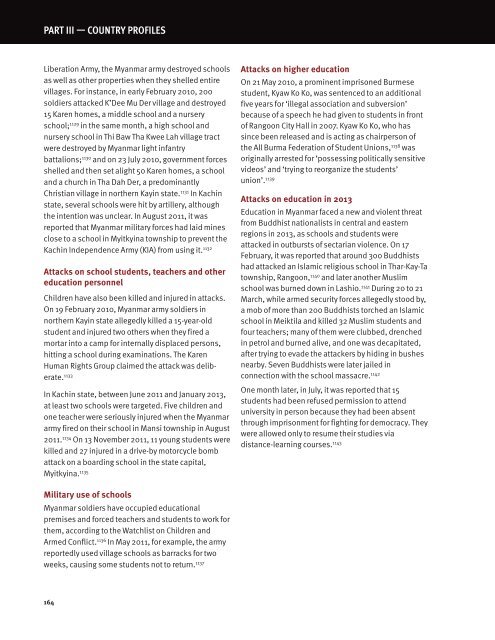Create successful ePaper yourself
Turn your PDF publications into a flip-book with our unique Google optimized e-Paper software.
PART III — COUNTRY PROFILeS<br />
Liberation Army, the Myanmar army destroyed schools<br />
as well as other properties when they shelled entire<br />
villages. For instance, in early February 2010, 200<br />
soldiers attacked K’Dee Mu Der village and destroyed<br />
15 Karen homes, a middle school and a nursery<br />
school; 1129 in the same month, a high school and<br />
nursery school in Thi Baw Tha Kwee Lah village tract<br />
were destroyed by Myanmar light infantry<br />
battalions; 1130 and on 23 July 2010, government forces<br />
shelled and then set alight 50 Karen homes, a school<br />
and a church in Tha Dah Der, a predominantly<br />
Christian village in northern Kayin state. 1131 In Kachin<br />
state, several schools were hit by artillery, although<br />
the intention was unclear. In August 2011, it was<br />
reported that Myanmar military forces had laid mines<br />
close to a school in Myitkyina township to prevent the<br />
Kachin Independence Army (KIA) from using it. 1132<br />
Attacks on school students, teachers and other<br />
education personnel<br />
Children have also been killed and injured in attacks.<br />
On 19 February 2010, Myanmar army soldiers in<br />
northern Kayin state allegedly killed a 15-year-old<br />
student and injured two others when they fired a<br />
mortar into a camp for internally displaced persons,<br />
hitting a school during examinations. The Karen<br />
Human Rights Group claimed the attack was deliberate.<br />
1133<br />
In Kachin state, between June 2011 and January 2013,<br />
at least two schools were targeted. Five children and<br />
one teacher were seriously injured when the Myanmar<br />
army fired on their school in Mansi township in August<br />
2011. 1134 On 13 November 2011, 11 young students were<br />
killed and 27 injured in a drive-by motorcycle bomb<br />
attack on a boarding school in the state capital,<br />
Myitkyina. 1135<br />
Attacks on higher education<br />
On 21 May 2010, a prominent imprisoned Burmese<br />
student, Kyaw Ko Ko, was sentenced to an additional<br />
five years for ‘illegal association and subversion’<br />
because of a speech he had given to students in front<br />
of Rangoon City Hall in 2007. Kyaw Ko Ko, who has<br />
since been released and is acting as chairperson of<br />
the All Burma Federation of Student Unions, 1138 was<br />
originally arrested for ‘possessing politically sensitive<br />
videos’ and ‘trying to reorganize the students’<br />
union’. 1139<br />
Attacks on education in 2013<br />
Education in Myanmar faced a new and violent threat<br />
from Buddhist nationalists in central and eastern<br />
regions in 2013, as schools and students were<br />
attacked in outbursts of sectarian violence. On 17<br />
February, it was reported that around 300 Buddhists<br />
had attacked an Islamic religious school in Thar-Kay-Ta<br />
township, Rangoon, 1140 and later another Muslim<br />
school was burned down in Lashio. 1141 During 20 to 21<br />
March, while armed security forces allegedly stood by,<br />
a mob of more than 200 Buddhists torched an Islamic<br />
school in Meiktila and killed 32 Muslim students and<br />
four teachers; many of them were clubbed, drenched<br />
in petrol and burned alive, and one was decapitated,<br />
after trying to evade the attackers by hiding in bushes<br />
nearby . Seven Buddhists were later jailed in<br />
connection with the school massacre. 1142<br />
One month later, in July, it was reported that 15<br />
students had been refused permission to attend<br />
university in person because they had been absent<br />
through imprisonment for fighting for democracy. They<br />
were allowed only to resume their studies via<br />
distance-learning courses. 1143<br />
Military use of schools<br />
Myanmar soldiers have occupied educational<br />
premises and forced teachers and students to work for<br />
them, according to the Watchlist on Children and<br />
Armed Conflict. 1136 In May 2011, for example, the army<br />
reportedly used village schools as barracks for two<br />
weeks, causing some students not to return. 1137<br />
164


